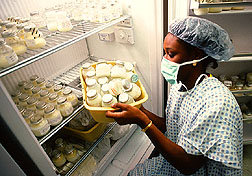Milk Is Milk . . . or Is It?
|
|
It's easy to milk an elephant--if you know how. Just ask veterinarian Eric Miller, director of animal health and research at the St. Louis Zoo.
Four years ago, one of the zoo's pachyderms, named Pearl, had trouble nursing her newborn calf, Raja. Miller and other members of the zoo staff devised a way to feed Raja. They gave Pearl the lactation-stimulating drug oxytocin. Then the animal staff restrained her and used a human breast pump to get enough milk to bottle-feed Raja.
After Pearl was able to nurse, some milk was left over--milk that helped scientists in Houston, Texas, who were studying human infant nutrition.
Nutritionists Teresa A. Davis and Peter J. Reeds have been studying the milks of various mammal species to find how the nutrients they contain contribute to development of their young. Understanding the ways milks differ may lead the scientists to better formulas to nourish human babies who can't breast-feed. This is especially important for premature infants who may not have the digestive systems necessary to break foods down into what they need for life.
Human feeding formulas are routinely tested on animals--but the results could be misleading if human milk differs dramatically from that of the other mammals. Until Reeds and Davis did this study, most comparisons had been between human and cow's milk--which is what most infants get after weaning.
Davis and Reeds found that amino acids, the building blocks of protein, are the same in breast milk throughout the animal kingdom. However, the concentrations of these amino acids can vary almost tenfold among species. That means that while a human and a sea lion may have different concentrations of amino acids, the basic makeup of both human and sea lion milk will be similar.
Three amino acids--glutamate, leucine, and proline--make up 40 percent of the total amino acids in all animals' milk. That commonality gives researchers more confidence in their animal-tested formulas. But why are some amino acids present in different ratios between species?
While all primates--humans, chimps, and apes--have very similar milk components, human milk has the highest cystine content, with the great apes coming in second. Cystine is believed to play more of a role in body maintenance than in growth. So Davis and Reeds reasoned that the high cystine levels reflected the fact that human and ape babies take longer to mature than their primate relatives. In fact, the closer any two animal species are on the evolutionary tree, the more likely their milks are to be similar.
Enter Miller's elephant milk: Davis and Reeds wanted to know if elephants, another slow-growing animal, also had high cystine levels. They didn't.
Researchers now speculate that high cystine levels might relate to brain and eye development. That's because cystine is used to make another compound called taurine, which is highly concentrated in both the brain and eyes.
In fact, cystine levels were higher, the further up the primates were on the evolutionary tree.
And there seems to be a connection between amino acid content and a species' particular needs. For example, both tiger and house cat milks have a high arginine content. It's an important amino acid for all felines, because kittens and cubs can't synthesize it. In fact, cat parents must get all the arginine they need from food, while other mammals synthesize it.
"The good news is there is more similarity than difference between species," said Davis. "And we will keep studying how these amino acid combinations work to promote optimum growth."--By Jill Lee, Agricultural Research Service Information Staff, 6303 Ivy Lane, Greenbelt, Maryland 20770, phone (301) 344-2781.
Teresa A. Davis and Peter J. Reeds are at the USDA-ARS Children's Nutrition Research Center, Baylor College of Medicine, 1100 Bates St., Houston, TX 77030-2600; phone (713) 798-7147, fax (713) 798-7171.
"Milk Is Milk . . . or Is It?" was published in the May 1998 issue of Agricultural Research magazine. Click here to see this issue's table of contents.







